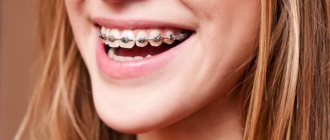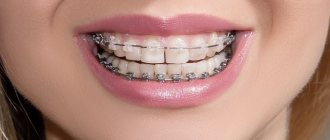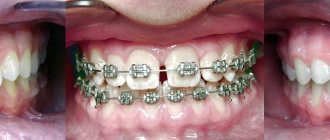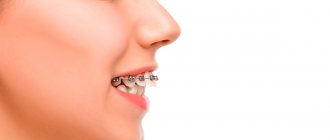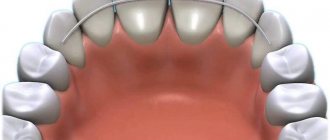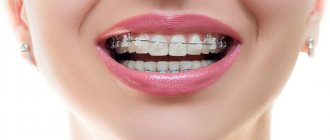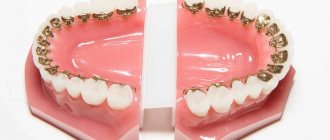This is a headache and a nightmare for any orthodontist: a patient who has had his braces removed and given a removable retainer and instructions for its use returns after some time with complaints about the curvature of his previously straight teeth. The retention period is the most psychologically difficult part of the treatment. Everything is already perfect, and then you have to wear a retainer. Yes, there are other reasons for the unsuccessful outcome of the correction. And although they are much less common, let’s talk about them in more detail.
Why are they trying to remove the diastema?
The space between the front teeth can reach 5–6 mm, without affecting a person’s ability to work or his career opportunities. Russian stars Konstantin Raikin and Nikolai Karachentsov, their American colleague Eddie Murphy, singers Madonna, Vanessa Paradis and Alla Pugacheva reached stellar heights without being embarrassed by a small interdental gap. Moreover, today the diastema of the front teeth has actually become a passport to the world of fashion and style. At least a dozen famous models with gaps stride along the world's main catwalks. Among them are Georgia Jagger and Lara Stone, Ashley Smith and Lindsay Wixson.
All these people adequately perceive their “wrong” teeth and the problems they create. But not everyone is ready to come to terms with such a natural feature. What annoys people with gap hair the most?
- The aesthetics of a smile is violated, in their understanding.
- Lisp and stridence caused by diastema are incorrect pronunciation of whistling and hissing consonants.
- Saliva splashing during conversation and tongue visible in the lumen.
It is with such complaints that they turn to the dental clinic. To offer the optimal treatment method, doctors carefully diagnose patients, paying special attention to the childhood period of their life.
Lisp is an unpleasant moment at the very beginning
The first thing that clients of dental clinics complain about is the loss of clarity of sounds when speaking. Let's face it, this is awkward. You can feel like a very small child who is about to be taken to a speech therapist. Immediately after installing braces, speech becomes lisping and all voiced sounds disappear. But you shouldn’t be particularly afraid of this - the defect will go away in a few days when you get used to articulating, taking into account the additional structure in your mouth. If you are very confused, you can do the installation on Friday, and then over the weekend your speech will become more or less clear. Full recovery usually takes at least a week. But then there are no problems with this anymore.
When and why does a gap appear between the incisors?
In most cases, the gap between a child’s teeth is false. It is formed due to a mismatch between the rapidly growing jaw bones and small baby teeth and disappears on its own when the bite changes. A diastema formed already with permanent teeth is called true and, in the absence of correction, remains with the person forever.
Dentists divide the reasons for its appearance into objective and local subjective. Among the objective ones the leaders are:
- hereditary factor;
- structural features of the jaw bone and attachment of the labial frenulum;
- typical orthodontic problems associated with changes in the normal position of teeth in the jawbone.
Local habits include bad habits that contribute to the “breaking apart” of teeth: prolonged sucking of a pacifier and finger, as well as a persistent commitment to chewing hard objects. In people over 30 years of age, the incisors can also “move apart” if periodontal disease is not treated. The tissues that dissolve in this process deprive the teeth of support and provoke their displacement.
To choose the right way to correct a diastema in Moscow , it is necessary not only to carry out a number of specific diagnostic procedures, but also to find out exactly when the gap became noticeable and what the patient himself associates with its appearance.
Negative consequences of wearing braces: common myths
Is there life after braces? At the very beginning of the journey (that is, orthodontic treatment), the answer to this question seems to be negative. But the cherished hour is getting closer and closer, in which the shackles (that is, braces) will fall, and the world will see your even, dazzling smile. But will everything be so optimistic? Let's look at the typical fears that sometimes plague owners of braces.
Complications after braces
Complications after braces are possible and, like any complications, quite unpleasant. This may be recession (that is, drooping) of the gums, disruption of the integrity of the neurovascular bundle, resorption of the roots, etc.
We will try to reassure you: firstly, although these are sad, but infrequent situations - for example, gum recession is observed in only 4% of patients, and this is the most common complication. Secondly, many problems are associated with excess pressure on the teeth, that is, with an incorrectly calculated load on the braces. If you have chosen an experienced, professional doctor, then most likely you will not face such troubles. To be on the safe side, you can take a panoramic photo once every six months that will show all the current changes.
Harm from braces
Harm is too strong and broad a word: everyone can understand something different by it. Here are the most common causes of distress in those who remove braces. First of all, this is a change in the color of tooth enamel. In most cases, hygienic cleaning of the tooth cavity and patience help: about a month after removing braces, the tone of the enamel evens out. You can also talk to your doctor about the suitability of whitening procedures.
It happens that girls complain about changes in the oval of their face. Not all orthodontists agree that it is braces that make the face thin and seem longer. Nevertheless, this opinion exists among patients. Whatever the reason for the changes, special face gymnastics will help. By the way, it will also be a good prevention of aging.
After braces, teeth become crooked
Curvature of teeth after braces can theoretically (!) happen to anyone, and here’s why. The even bite you have achieved, although it looks very natural, is actually not so. And after you remove the braces that hold your teeth in the correct position, they will immediately try to return to their original places. But these same “old places” are no longer there: the bone tissue has been rebuilt, the blood vessels, ligaments and soft tissues have moved... So there is nowhere for the teeth to return. Therefore, they can simply move anywhere - and the result will be even more disastrous than it was before the installation of the orthodontic system.
But in fact, such a sad option is practically excluded for most patients. It awaits you only if you do not listen to your doctor and refuse to install retainers - special devices that can permanently keep your teeth in the correct position.
Gaps between teeth after braces
This is also theoretically (!) possible. The reasons are the same as in the case of crooked teeth. After braces, they try to return to their usual place, but it turns out to be occupied. As a result, the teeth stand up as they please and, as one of the consequences, a gap forms between the teeth. Installing retainers will help to avoid such developments.
Braces give me headaches
Headache, just like, for example, muscle pain, can really become a companion to braces. Everything in the head is located quite close, and the impact on the structures in the maxillofacial area, namely the installation of even the most expensive braces, can affect other organs. Pain is always an SOS signal from the body. And you shouldn’t tolerate it; be sure to consult your orthodontist. And also, see a neurologist: headaches can have many causes that have nothing to do with orthodontic treatment.
Expert opinion
“Orthodontic treatment of a bite to achieve a beautiful smile is a complex process: any patient can understand this by how carefully the brace system is installed, how often its elements have to be adjusted and how expensive it is. It is quite natural that some difficulties may arise, both directly during treatment and after removal of the orthodontic apparatus.
I can advise anyone who decides to have it installed, first of all, to be very careful in choosing their attending physician. Only the high professionalism of an orthodontist can provide you with excellent results - a correct bite and a beautiful smile. Your teeth should not become a field for experiments by an unqualified specialist - let me remind you that you pay a lot of money for his work and trust him with your health and appearance!
Also, be proactive and caring: if you have a question, ask your doctor, not your neighbor or a “more experienced” braces wearer. And if you have found “your” orthodontist, then carefully follow all his recommendations - this will protect you from many problems.
Also keep in mind that your communication with your doctor will not end after the bite is corrected: you will have a very long (about twice as long as you wore braces) period of retention - that is, maintaining the result. Orthodontic devices of this period are called retainers; they are easy to care for and almost invisible in the mouth. They are the ones who will help you avoid disappointments and complications after removing braces.”
How to remove a gap between teeth?
When choosing a technique, the doctor is guided by the identified cause of diastema formation. Various treatment methods have been developed:
- surgical - associated with excision of the frenulum or bone tissue or with the removal of periodontal tissue affected by the inflammatory process;
- orthodontic, which involves long-term wearing of a special design that returns the teeth to their normal position;
- artistic restoration of the diastema using modern photopolymers or ceramic plates covering the gap.
After surgery, you will need to wear an orthodontic appliance to keep your teeth in the correct position. Only with its help will the gap between the incisors be completely closed.
Oral irritation is a problem that should not be tolerated
The mouth has difficulty adjusting to braces, not only in terms of articulation, but also in terms of freedom of movement. Any staples take up space and don't allow your lips to fit as they are used to. In addition, the movement of the cheeks is slightly limited. If you feel discomfort in your cheeks or perhaps have ulcers or scratches on them, make an appointment with your dentist immediately. Most likely, the cheek is injured by the protruding arch of the bracket. The doctor should trim it or give you special wax, with which you can make the edge of the arch smooth and safe. If braces severely irritate the mucous membranes of the lips, you should consider changing them to lingual ones. They do not come into contact with the mucous membrane at all and do not cause irritation. However, before the change, you should definitely discuss your concerns with your doctor; perhaps he will recommend being patient a little longer until you adapt.
Painful sensations are everything. Ideally, any discomfort should disappear within 7-10 days. This time is enough for you to fully adapt to the new sensations in your mouth. After this, all that remains is to get used to the features of the new oral hygiene.
Orthodontic correction of a gap
In childhood, a variety of removable plates and artificial crowns are used, which are not highly aesthetic, but solve the problem quickly and effectively.
For adults, the anomaly is corrected with fixed metal or invisible ceramic braces, as well as lingual systems attached to the inside of the teeth. According to indications and if the patient wishes, an individual mouth guard can be made - a removable plate made of an elastic transparent composite.
How to maintain the results of orthodontic treatment for a long time?
The doctor removes the braces when the teeth are in the desired position. After this, the patient is usually sent for professional cleaning and removal of tartar. Metal structures make it difficult to clean the enamel, so during long-term orthodontic treatment, hard deposits often remain on it.
After professional oral hygiene, the doctor selects removable or non-removable structures for the patient that will record the results of treatment and prevent the teeth from moving apart again. Depending on the initial position of the canines and incisors, the duration and complexity of the bite correction, the orthodontist may recommend:
- permanent or temporary wearing of mouth guards,
- installation of retainers.
The mouthguard is usually a removable cover made of transparent plastic. It is made from an individual impression so that it accurately matches the shape of the patient’s jaw. A properly selected mouthguard does not affect diction and does not cause pain or discomfort. The patient can remove, put on and clean it independently. The orthodontist will tell you how often and for how long you need to wear a mouthguard. Immediately after removing the braces, doctors advise wearing them at night and for several hours during the day. Over time, when the teeth get used to the correct position, you can do this less often.
A permanent retainer is a thin steel wire that is attached to the back surface of the incisors and canines. It prevents them from moving apart, thereby preventing the gap from reappearing. The non-removable design is not noticeable during a conversation or when smiling, and does not interfere with chewing food or talking. The doctor secures the arch with glue or composite materials that do not adversely affect the condition of the enamel.
Some patients have to wear a retainer for life, while others may have to remove it after a few years. The timing depends on the age at which the bite correction was performed and the initial position of the teeth.
Features of proper care
To prevent teeth from deteriorating after braces, it is important to follow basic oral care rules. These are 3 key recommendations:
- Proper hygiene . If you have braces, then from now on you won’t be able to get by with just a toothbrush. In addition, special brushes, small brushes, dental floss and mouthwash are also used. It is also advisable to use an irrigator to wash the oral cavity. Such hygiene is necessary to prevent caries, so that teeth do not deteriorate.
- Power control . Braces are a fairly fragile structure that can be damaged by hard foods, such as nuts, crackers, hard cheese and others. Avoid such foods, as well as sticky foods. If a breakdown or deformation of structural elements suddenly occurs, you should consult a doctor as soon as possible. It is contraindicated to remove braces on your own.
- Examinations with a doctor . In addition to the emergency cases described above, you also need to regularly go to the doctor for preventive examinations. Most often this is once a month, but an individual schedule is drawn up for each patient.
What are rubber bands on braces used for?
Doctors explain in detail why you need to wear rubber bands on braces. Usually, the attachment of elastics is indicated at the beginning of wearing braces and at the final stage of correction. Situations in which the orthodontist will install traction:
- Impacted teeth. With an incorrect bite, permanent teeth do not always erupt on time and in their places. Sometimes single teeth grow late, when their place in the jaw is already taken by other teeth. Or they grow to an incomplete size. Orthodontic traction helps to stretch the tooth and put it in the right place. To do this, a button is attached to the unit, an elastic connected to the bracket is attached to it, and they move the tooth in the desired direction. When the crown appears completely, the button is replaced with a regular bracket, and a metal arch begins to be responsible for the correction.
- Malocclusion. When correcting a malocclusion, elastics are worn at the end of treatment to align the jaw rows relative to each other. In case of distal pathology, fixation of elastic fastenings is performed symmetrically - the lower jaw is pulled towards the upper jaw. When correcting an open bite, the upper and lower teeth are pulled so that the upper incisors overlap the lower ones and disocclusion is eliminated. Using special schemes, pathologies of crossbite and mesial bite are eliminated.
Elastics are also used for proper alignment of the jaw rows relative to each other. Jaw displacement is a common intermediate stage of correction. Temporary asymmetry is caused by the return of separately growing teeth to the bite line, the elimination of teeth and diastemas, or the removal of some units. Elastics quickly eliminate local damage.
Elastic traction almost always accompanies wearing braces, so it is useful for patients to know the specifics of fixation and the features of wearing elastic bands.
Why is an unclosed diastema dangerous?
If a diastema appears, you need to contact your dentist for help in eliminating it. The orthodontist will tell you why there is a gap between the teeth and whether it can be corrected. If the anomaly is caused by serious changes in the structure of the jaw, then the orthodontist will examine it using X-ray equipment or a CT scanner.
If the situation is unfavorable, the doctor will offer treatment options. If you leave the diastema, gum disease may appear, “pockets” may form in the periosteum, and incisors may fall out prematurely. Pathology affects pronunciation. A person pronounces hissing and whistling sounds worse.
How to put rubber bands on braces
Orthodontic elastic bands for braces are fixed on the teeth according to certain patterns. The type of elastics - their diameter, length, force of influence - is selected by the orthodontist. He also voices the peculiarities of fastening rubber bands on the teeth.
Basic schemes for fastening elastics:
- For two teeth - connect a pair of teeth of the upper and lower jaws.
- Triangle (V-shaped) - the elastic passes through the braces of two upper teeth and through one of the lower jaw. Or vice versa.
- Box fastening - performed on 4 teeth.
- Combined option - the doctor uses several schemes at the same time.
Rubber bands for correct bite provide the desired effect for no more than 12 hours. Within an hour after installation, the latex rods weaken by 30% and soon require complete replacement. Therefore, the patient is trusted to fix the elastics to the teeth - either by hand or using a special device. The tool looks like a large plastic hook. They are convenient for attaching elastic bands to braces. The braces themselves have small hooks on which elastic rings are placed. The treatment plan and teeth for fixing the elastics are indicated by the doctor.
Soldatenkova Alina
Teenagers quickly learn to put rubber bands on braces on their own. The doctor’s task is to ensure that patients accurately select the abutment teeth and do not confuse the places of fixation.
Treatment time is significantly reduced if the patient remembers three rules:
- Wear the braces for a strictly prescribed time - 12 hours (at night) or 24 hours, and remove them while eating and brushing your teeth.
- Replaces elastics every 12 hours when worn daily - morning and evening.
- Change both rubber bands, if at least one breaks - the force of pressure on the teeth on both sides should remain the same.
Indications for installation
There are many indications for installing a brace system; these devices help to cope with both minor malocclusions and very serious pathologies. Common anomalies: open and deep bite. In the first case, the rows may not have points of contact in the frontal zone or on the sides, and in the second, the lower jaw strongly overlaps the upper jaw in front.
Braces can also help with facial asymmetry, crossbite (one of the jaws is underdeveloped), diastal (severe protrusion of the upper jaw) and medial bite (protrusion of the lower jaw). Other indications include severe crowding, rotation of units around their axis, as well as the presence of slots of different sizes, etc.
Only an experienced specialist can determine the need to install orthodontic structures and only on the basis of a preliminary examination of the patient’s oral cavity. The doctor will tell you which braces will be most effective and will solve existing problems as quickly as possible. The orthodontist will also tell you about all possible complications and symptoms that should alert you.
Consequences after removing braces
Consequences of braces are possible even after they are removed. Possible problems include:
- Stains on enamel . This effect is possible due to poor hygiene. Teeth whitening and remineralization will help correct the situation.
- Changing the shape of the face . This is a very rare occurrence. And if the patient experiences drooping of the cheeks or changes in the nasolabial folds, then the defects are quickly restored with the help of special gymnastics.
- Demineralization of enamel . Another potential disadvantage of braces is the weakening of the enamel. This is due to the fact that under the structure the hard tissues of the tooth did not receive enough of the necessary microelements. To minimize the risk of such a complication, courses of treatment to strengthen the enamel (remineralization) are prescribed after braces.
- The teeth returned to their previous position . To prevent teeth from moving apart after braces, the patient needs to wear retainers for some time. These are special orthodontic splints that are placed on the teeth to secure the result.
Contraindications
In addition to the indications for installing braces, there are also contraindications. They are usually divided into relative and absolute. The first ones are only a temporary obstacle; they can be dealt with by contacting a highly qualified specialist. This usually includes the presence of small neoplasms on the soft tissues of the oral cavity, as well as inflammatory processes.
Periodontal disease and periodontitis are not absolute contraindications; after a course of therapy, you can begin installing braces. Also, structures can be installed after treatment of bruxism, if the patient has crowns and artificial teeth. Having an allergy to metal will not be a contraindication, since today braces are made from a variety of materials.
Absolute contraindications are those that cannot be eliminated (HIV, oncology, diabetes and others). In this case, the patient may be offered alternative solutions to existing pathologies.
